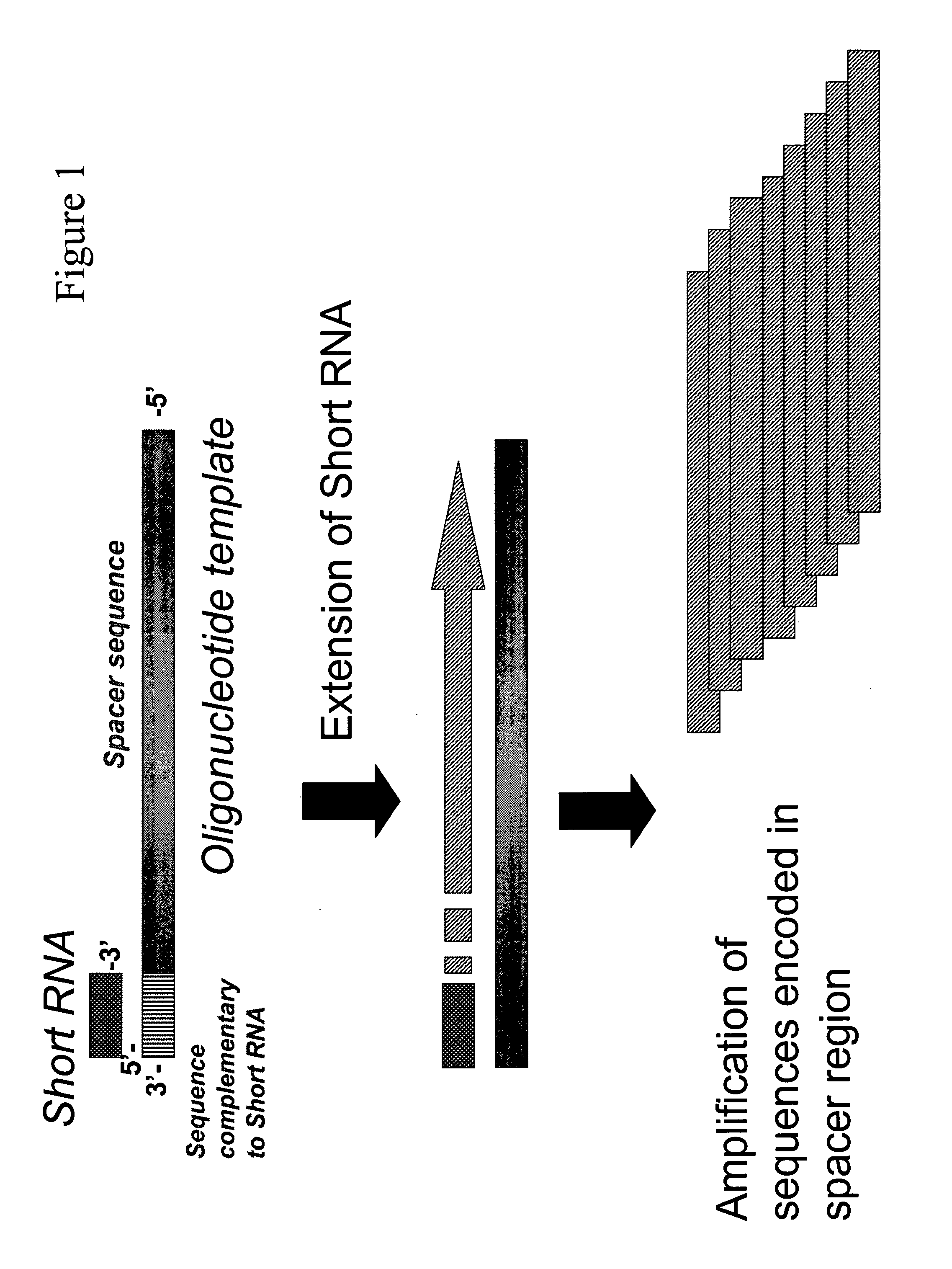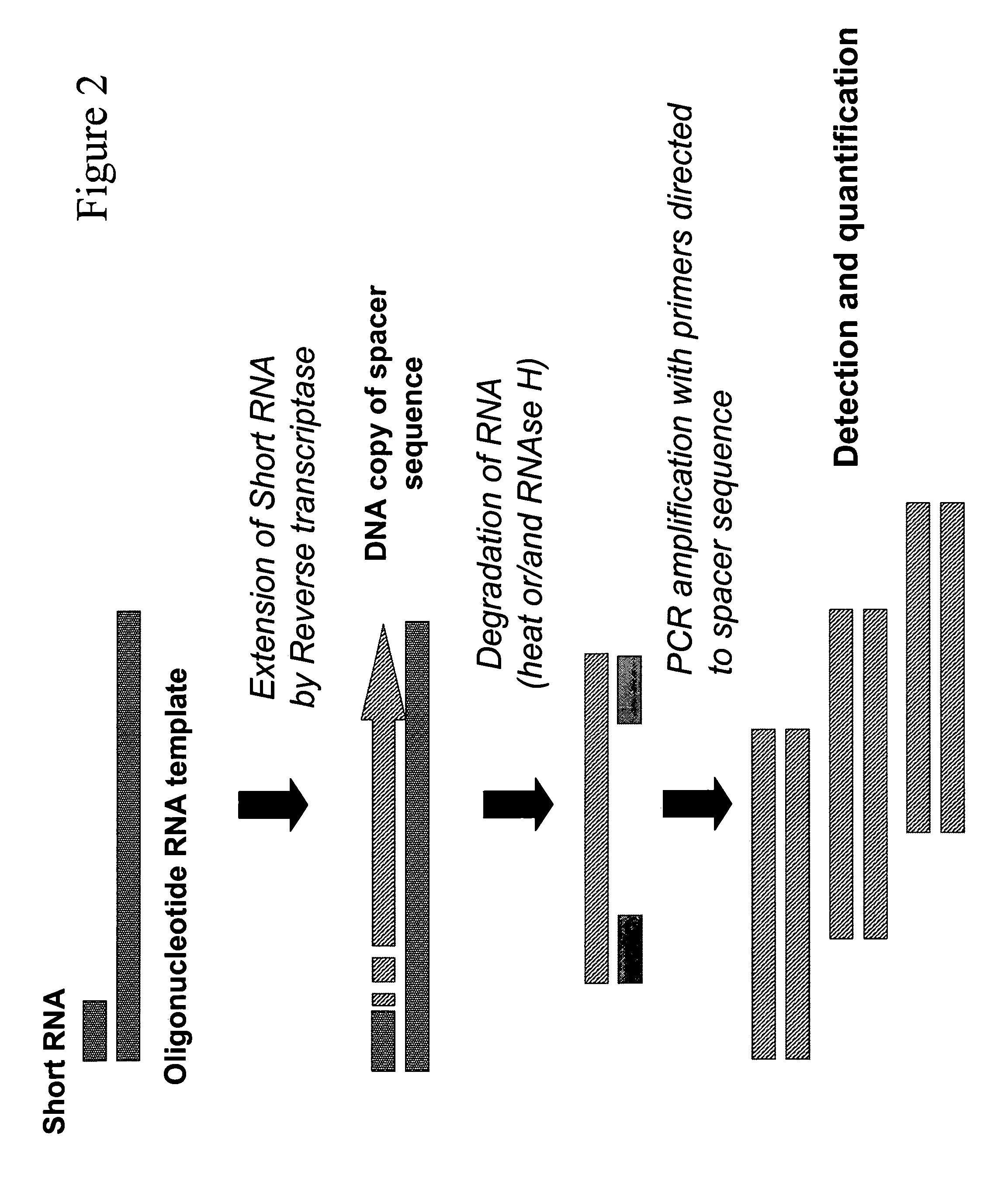Method for quantitative detection of short RNA molecules
a quantitative detection and short rna technology, applied in the field of methods of identifying and quantifying short rna molecules, can solve the problem of extremely difficult design of two non-overlaping dna primers
- Summary
- Abstract
- Description
- Claims
- Application Information
AI Technical Summary
Benefits of technology
Problems solved by technology
Method used
Image
Examples
example 1
[0105] Extension using DNA templates:
[0106] Serial dilutions of let7-a miRNA (5′-UGAGGUAGUAGGUUGUAUAGUU-3′) are prepared to the concentration range 0.01 nM to 100 nM.
[0107] a) A 1 ul aliquot of let 7a miRNA solution is combined with a 1 ul aliquot of a 2 uM solution of DNA oligonucleotide Let7A-T72 (5′-CTAATACGACTCACTATAGGGAGAGCTGAAATCACAAATACAACGAATCGAG TAAACTATACAACCTACTACCTCA-3ddC-3″) in 20 ul of the reaction buffer: 10 mM Tris, 50 mM NaCl, 10 mM MgCl2, 1 mM dithiothreitol, 0.2 mM dNTPs (desoxyribonucleotides triphosphates) (pH 7.9) containing 1 U of Klenow fragment of DNA Polymerase 1 (New England Biolabs, Beverly, Mass.) and incubated at 37° C. for 30 mm.
[0108] b) A 1 ul aliquot of the solution of let 7a miRNA is combined with a 1 ul aliquot of a 2 uM solution of DNA oligonucleotide Let7A-T72 (5′-CTAATACGACTCACTATAGGGAGAGCTGAAATCACAAATACAACGAATCGAG TAAACTATACAACCTACTACCTCA-3ddC-3″) in 20 ul of the reaction buffer: 20 mM Tris, 10 mM KCl, 10 mM (NH4)2SO4, 2 mM MgSO4, 0.1% Trit...
example 2
[0112] Multiplex detection of let 7a ( 5-UGAGGUAGUAGGWUGUAUAGUU) and let 7c miRNAs (5-UGAGGUAGUAGGUUGUAUGGUU) is performed as described above, with the following modifications: Combined serial dilutions of let 7a and let 7b are mixed with DNA templates Let7A-T72 (5′-CTAATACGACTCACTATAGGGAGAGCTGAAATCACAAATACAACGAATCGAG TAAACTATACAACCTACTACCTCA-3′ddC) and Let7C-T71 (5′-CTAATACGACTCACTATAGGGAGAGCGATAAATTAGAATTCGAACCATACAA CCTACTACCTCA-3′ddC).
example 3
Reverse transcription-PCR.
[0113] Different concentrations of serially diluted let 7a miRNA (1 pM-1 nM) are mixed with 2 ul of 1 nM RNA template: 5′-UAUUCCAGACUCACCUUAUACACAGCUGAAAUCACAAAUACAACGAAUCG AGUAAACUAUUCAACCUACUACCUCA in reaction buffer containing 50 mM Tris, 50 mM KCl, 2 mM MgCl2, 0.2 mM dNTPs and 2U of M-MLV Reverse Transcriptase (Promega, Madison, Wis.) and incubated for 20 min at 45-50° C. (total volume 50 ul). The reverse transcriptase is heat inactivated for 10 min at 80° C. and reaction is supplemented with 1 uM of oligonucleotide primers directed to the spacer region 5-TTACTCGATTGCTTGTATTTGT and 5-TTCCAGACTCACCTTATAC, 2 U Taq Polymerase (Promega, Madison, Wis.), and 5 ul of 1 / 10000 dilution of SYBR Green dye (Invitrogen).
[0114] The reaction is placed into an I-Cycler Real-Time PCR system (Biorad) and subjected to real-time PCR performed according to manufacturer's instruction. The amplification is conducted for 30 cycles comprising the following steps: 15 s at 95°...
PUM
| Property | Measurement | Unit |
|---|---|---|
| Length | aaaaa | aaaaa |
| Size | aaaaa | aaaaa |
| Level | aaaaa | aaaaa |
Abstract
Description
Claims
Application Information
 Login to View More
Login to View More - R&D
- Intellectual Property
- Life Sciences
- Materials
- Tech Scout
- Unparalleled Data Quality
- Higher Quality Content
- 60% Fewer Hallucinations
Browse by: Latest US Patents, China's latest patents, Technical Efficacy Thesaurus, Application Domain, Technology Topic, Popular Technical Reports.
© 2025 PatSnap. All rights reserved.Legal|Privacy policy|Modern Slavery Act Transparency Statement|Sitemap|About US| Contact US: help@patsnap.com



